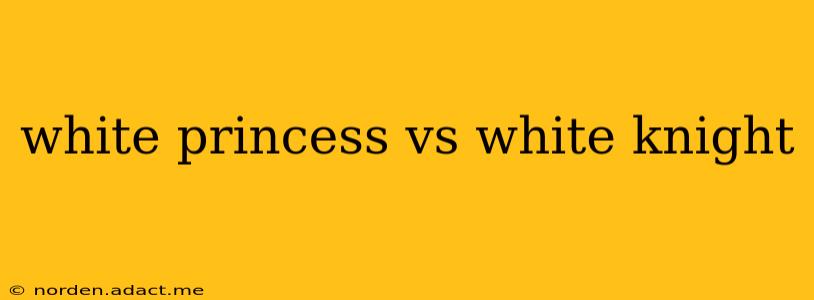The terms "White Princess" and "White Knight" evoke images of fairytale romance and idealized chivalry. However, these archetypes, often used in personality typing and fictional narratives, represent distinct behavioral patterns and motivations. Understanding the nuances between them reveals insightful perspectives on interpersonal dynamics and relationship dynamics. This exploration delves into the key distinctions between these fascinating figures, answering common questions along the way.
What are the Key Differences Between a White Princess and a White Knight?
The core difference lies in their primary motivations and approach to relationships. A White Princess, often perceived as passive and dependent, seeks protection and security, prioritizing emotional comfort and romantic ideals. The White Knight, on the other hand, is driven by a desire to rescue and protect, finding fulfillment in selfless acts and demonstrating heroism. While seemingly complementary, their contrasting approaches can lead to imbalances and conflict within relationships.
What is a White Princess Personality Like?
The White Princess archetype is often associated with traits such as:
- Passivity: They may rely on others to take initiative and solve problems.
- Emotional Dependence: Their well-being is heavily influenced by the opinions and actions of those around them.
- Idealistic Romanticism: They often harbor a strong belief in fairy tale endings and "happily ever afters."
- Vulnerability: They are open and expressive about their emotions, sometimes to a point of vulnerability.
- Need for Protection: They seek a strong and reliable partner who can provide a sense of safety and security.
It's crucial to note that these traits aren't inherently negative. Vulnerability and a desire for emotional security are valid and healthy needs. However, an overreliance on these traits can hinder personal growth and independence.
What is a White Knight Personality Like?
The White Knight archetype is characterized by:
- Selflessness: They prioritize the needs of others above their own.
- Heroic Mentality: They seek opportunities to rescue and protect those in need.
- Idealistic Morality: They adhere to strong moral codes and strive to uphold justice.
- Chivalrous Behavior: They exhibit acts of kindness, generosity, and courtesy.
- Desire to be Needed: Their sense of self-worth is often tied to being indispensable to others.
Similar to the White Princess, these traits are not inherently negative. However, an overwhelming desire to rescue and an inability to recognize personal boundaries can lead to codependency and burnout.
Are White Princesses and White Knights Compatible?
The compatibility between a White Princess and a White Knight depends heavily on individual personalities and the dynamics of their relationship. Their complementary traits can create a strong bond built on mutual admiration and affection. However, imbalances can arise if the White Knight becomes overbearing in their protectiveness, or if the White Princess fails to develop independence and self-reliance. Open communication, mutual respect, and a willingness to address imbalances are crucial for a successful relationship between these archetypes.
Can a White Princess be Strong and Independent?
Absolutely! The White Princess archetype is not a monolithic entity. A strong and independent woman can still embody some aspects of the White Princess archetype while possessing a strong sense of self and agency. This modern interpretation acknowledges the desire for emotional security without sacrificing personal strength and autonomy.
Can a White Knight be Vulnerable?
Yes, a White Knight can and should be vulnerable. Healthy relationships require emotional honesty and vulnerability from both partners. While the White Knight archetype often suppresses vulnerability to maintain the heroic persona, genuine connection requires embracing imperfection and emotional openness.
Conclusion: Beyond the Fairytale
The White Princess and White Knight archetypes offer valuable insights into human behavior and relationship dynamics. While often romanticized, understanding their nuances helps us appreciate the complexities of individual personalities and the importance of balance and healthy communication in relationships. Moving beyond the fairytale narrative allows for a more realistic and fulfilling exploration of these archetypes and their potential within real-world relationships.
